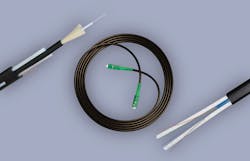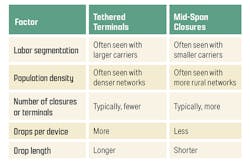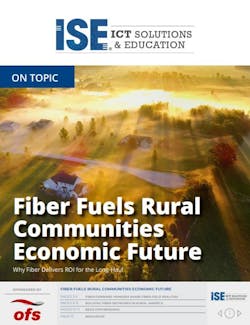And It Will Take Care of You
While the drop network is the shortest part of the network, it poses the most decision points for the typical network operator.
Working from the trunk network toward the house, there are multiple decisions to be made regarding the network architecture and components. This article will explore each section of the network, including the drop terminal, drop cabling, and the network in the home. These components are all interconnected, and the network should be examined as a whole, since decisions made for one part of the network may influence other parts of the network.
“Although the drop and in-home network only makes up the final short length of the overall network, the decisions made in this portion of the network can affect the cost, reliability, speed of deployment and ultimately the end user experience with your network.”
Section 1: Drop Terminal
An important decision is how to manage the drops at the terminal in the rural network. There are two main decision points.
The first decision point is whether to use a mid-span access closure/terminal or a pre-stubbed terminal, as shown in the following pictures.
A mid-span access procedure is the way drops have been done for decades. At the closure location, a short length of cable is stripped down to the buffer tubes. The fibers to be spliced are accessed and spliced to drops or pigtails, and the rest of the fibers are recoiled within the closure.
An alternative to this architecture is to pre-stub a terminal with a cable which is then spliced at a central closure location.
There are several factors that can help drive this decision. Many larger carriers with partitioned workforces often choose to use tethered terminals. They may have a “construction” crew that splices the terminals in place, and the “installation” crew then installs the final drop to the home.
However, many rural workforces don’t have the same level of segmentation, so that division of labor may not hold as much sway with the rural carrier.
Also, many rural areas may have some distance between homes, which means the tethered cables will need to be installed for quite some distance. Tethered terminals can make sense in more densely populated areas.
From a cost standpoint, labor rates for different operations can influence the decision process. If the cost of running the additional tethered length is small relative to the cost of splicing a closure, tethered lengths can make sense. However, in those instances where drop cable installation labor is pricey, it can be much more advantageous to install more closures and have shorter drop lengths.
A rough summary table is below.
The various types of closures and terminals can also be viewed as tools in a toolbox, and it may make sense to have tethered terminals in parts of the network and mid-span closures in other parts of the network. This approach is like the approach that is sometimes seen with splitter architecture, where centralized splits may be used in some parts of the network, where distributed splits are used in other areas.
The second decision point is whether to pre-connectorize or to splice/terminate in the field. For connectors, we believe that non-proprietary connectors provide sourcing flexibility to service providers by not locking them into a proprietary connector type. This will likely be a very important point over the next years, as we enter a time of unprecedented network building in rural areas across the country. There are many credible terminal options from different manufacturers using standard SC connectors that should be considered.
There is another alternative solution for drop cable management. Where previous networks may have either lashed or tie-wrapped drops to a strand, a new device known as Sherpa can be used to attach drop cables either to a trunk cable or to a strand. This device can be used with a wide variety of cables, and can significantly simplify drop management, especially in those situations where drop cables are mandated to have no more than a certain amount of separation from a host strand or cable. Figure 1 shows this device in action.
Section 2: Drop Cabling
Either flat or drop cables can be used in aerial or underground networks, and there are a wide variety of cables for different applications. Figure 2 shows different types of drop cables.
A relatively new option on the market is an EZ Bend drop cable that can be run outside and stripped to reveal a 900-micron InvisiLight ultra-bend insensitive cord inside. This option has the potential to eliminate the network interface device (NID) on the side of the house, saving both cost and optical loss. Figure 3 illustrates how this is done.
Section 3: In the Home
The network at the home has changed dramatically since the initial days of FTTH. Networks built prior to 2010 had the ONT almost always installed outside. Especially with the advent of wireless streaming video services, ONTs are now mainly installed indoors with wireless distribution inside the home.
A sometimes overlooked point, for the best location for wireless distribution, is often to place the ONT and wireless device at the center of the home. Ultra-bend insensitive fibers can enable these installations to occur quickly and virtually invisible inside the home, significantly enhancing the user experience.
These same fibers can also be used as network extenders, either enabling repositioning of the ONT, or with media converters and SFPs in a kit, enabling fiber service to be extended throughout the home.
While wireless network extenders are very well known, they’re often expensive and may or may not work. Extending the fiber network using in-home fiber can be a less expensive and higher performance choice, and may also reduce truck rolls caused by poor wireless performance.
Although the drop and in-home network only makes up the final short length of the overall network, the decisions made in this portion of the network can affect the cost, reliability, speed of deployment and ultimately the end user experience with your network. There are many tools that can be used to build the last portion of the access network. Here, we’ve described three considerations to use when you’re choosing the right tools for your toolkit. Use them well!
This on-topic report is a tool for States and their subgrantees (community service providers) on a mission to deploy deep fiber to every resident in every rural community. It’s also a tool for communities to advocate for themselves because it outlines why fiber is the way to ensure they are not left with “second class” broadband networks in the years ahead. Deploying deep fiber is not solely a technological choice. It’s the right thing to do. It’s the economic stimulant for rural communities across our country that deserve to thrive in today ’s hyper-connected world.
About the Author
Mark Boxer
Technical Manager, Solutions and Applications Engineering, OFS
Mark Boxer is Technical Manager, Solutions and Applications Engineering, OFS. He has more than 35 years’ experience in fiber. For more information, email [email protected] or visit: www.ofsoptics.com. You can also follow them on Twitter @ofs_optics, LinkedIn: https://www.linkedin.com/company/ofs/, and Facebook: https://www.facebook.com/ofsoptics/.






